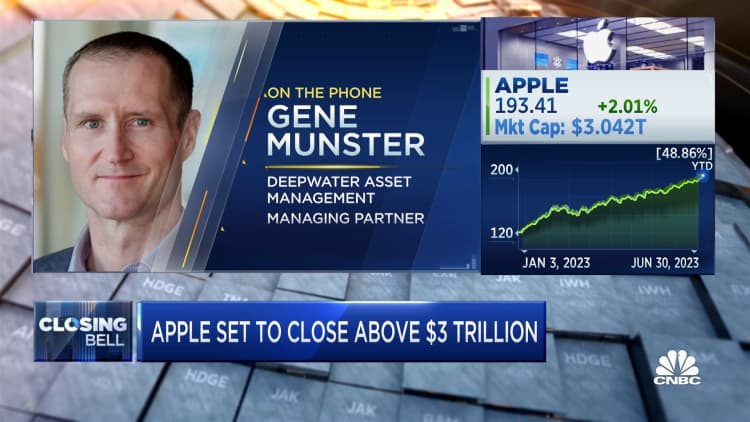BEIJING — Less than a year since augmented reality glasses startup Xreal started sales, the Alibaba-backed company is claiming shipments will soon reach 200,000 units.
Augmented reality (AR) technology allows digital images to be imposed over the real world.
It took the Chinese startup about four months to ship 100,000 units worldwide after a mass launch in late August 2022, co-founder Peng Jin told CNBC Thursday on the sidelines of Shanghai MWC.
"So you can do the math, how long it takes to do 200,000 units? It won't take that long," he said, without specifying a date.
It's unclear whether the pace of sales has changed. In late May, Xreal said it had sold 150,000 products globally.

"Right now, 200%, 300% [growth], it should be the norm, it doesn't really mean much," Jin said. "But I think it's very encouraging that people are accepting this new form factor, they are accepting this new experience."
Xreal's Air glasses cost $379, about a tenth of the $3,500 that Apple plans to charge for its Vision Pro headset when it's set to reach consumers next year.
The two products operate on different technology and their capabilities vary.
But both attempt to replicate the physical screen time experience with a large, virtual screen. That kind of digital replication falls under the category of spatial computing.
"We do see spatial computing as the major technological trend in the next maybe two, three decades," Jin said.
"I don't think the trick is in creating a whole bunch of original content so people can forget what they're doing and evolve into that. ... For us, the content is already there."
What's the demand for Apple?
The Financial Times on Monday reported, citing sources, that Vision Pro suppliers were only projecting a few hundred thousand units for the first year, down from Apple's internal sales target of 1 million. The report attributed the lowered forecast to the headset's complexity, and production difficulties.
Apple did not respond to a request for comment.
Worldwide shipments of VR headsets and augmented reality devices dropped by more than 12% to 9.6 million in 2022, according to CCS Insight.
Meta in June revealed its latest virtual reality headset, the Quest 3, with a $499 price tag. The company said further details would come in September.
Last week, analytics firm Canalys said it expects Vision Pro and related devices would have a user base of 20 million — five years out from the planned 2024 launch.
For Vision Pro to be successful, it needs to replace personal computers, said Nicole Peng, senior vice president, mobility, at Canalys. She said that's the value proposition Vision Pro has set up, which is different from what Xreal or Meta offer.
Xreal rebranded from Nreal in late May.
"Nreal, Xreal glasses still need to connect with a PC or a phone," Peng said. "That means when you're using it it's likely to [need] a wire to connect with either of the devices."
Right now, the company's primary product — Xreal Air — allows wearers of the headsets to see an enlarged version of a computer, gaming device or smartphone screen via a connected cord.
A forthcoming accessory called Xreal Beam, priced at $109, allows Xreal Air users to connect wirelessly to a device. Deliveries are set to begin in the second half of July, according to the official website.
People in 85 countries signed up to be notified about the Xreal Beam, Jin said. He said the company primarily sells to the U.S., Japan and South Korea, with China accounting for less than a third of sales.
In August, Xreal plans to expand online shipping to parts of Europe, Jin told CNBC. Currently customers in the region can only pay for international shipping via Amazon.com in the U.S.
Light-weight glasses
Xreal Air resembles a pair of ordinary sunglasses, and claims to weigh just 79 grams (less than 3 ounces).
Apple has not released such figures for Vision Pro. CNBC's Steve Kovach described the headset as "a bit heavy and uncomfortable" after 30 minutes. The device is strapped to the head, like goggles.
However, Vision Pro includes tech meant to give the user a digitally simulated immersive experience, while Xreal glasses project a screen in front of the wearer — who can also see the real world, Jin pointed out.
He said the company's research and development is looking for ways to make the glasses smaller, allow users to have a broader field of view and consume less power.
Despite being the number one best seller in smart glasses on Amazon, Xreal's AR glasses are still far from offering the perfect user experience.
Lack of content within Xreal's operating system and difficulties of connecting with an existing device were among the downsides highlighted in a Mashable review last week.
But the reviewer said that "despite some major hiccups and shortcomings, I still use this device almost daily, and it's become a major staple in my gaming experience."
Xreal raised $100 million in 2021, valuing the company at $700 million, CNBC reported. That was followed by a $60 million raise led by Alibaba last year.
Xreal has also partnered with Chinese electric car brand Nio for AR glasses that let people watch movies on a virtual large screen from inside the vehicle.
Jin said last week the company is looking to raise more capital, ideally at least a couple of hundred million dollars or more. He declined to say how much — or at what valuation — and noted he is not directly involved with those discussions.
— CNBC's Arjun Kharpal, Steve Kovach and Jonathan Vanian contributed to this report.


